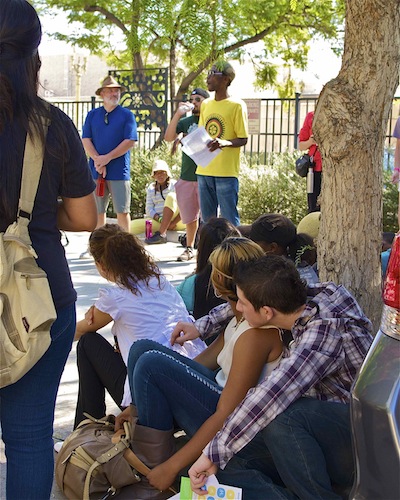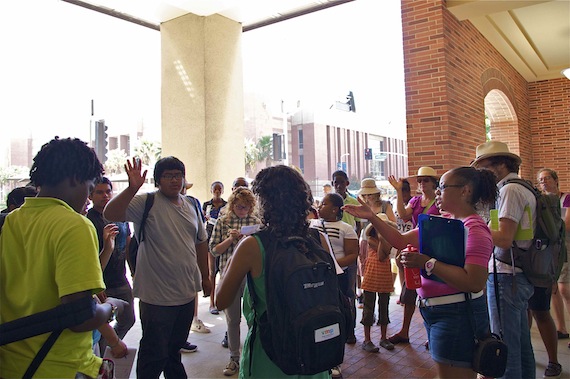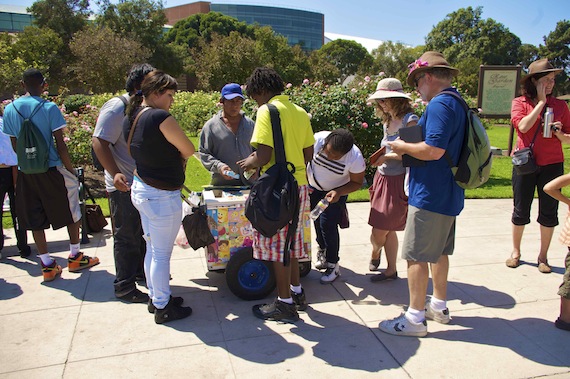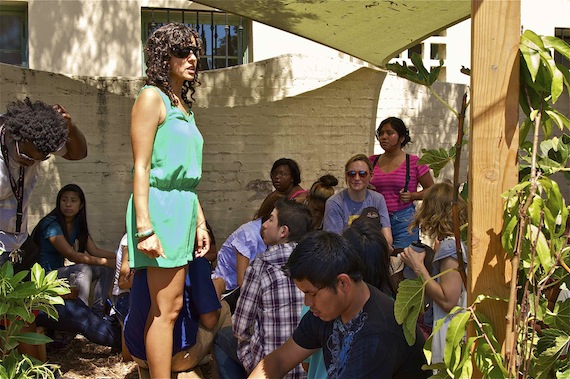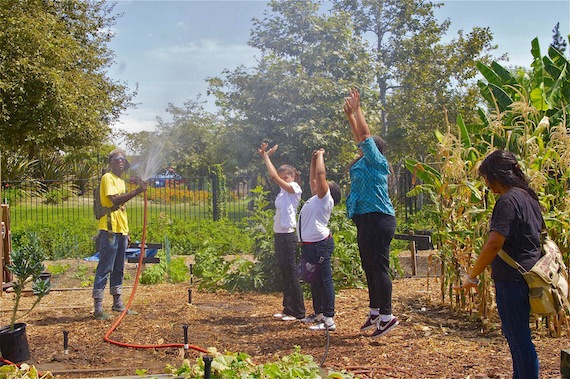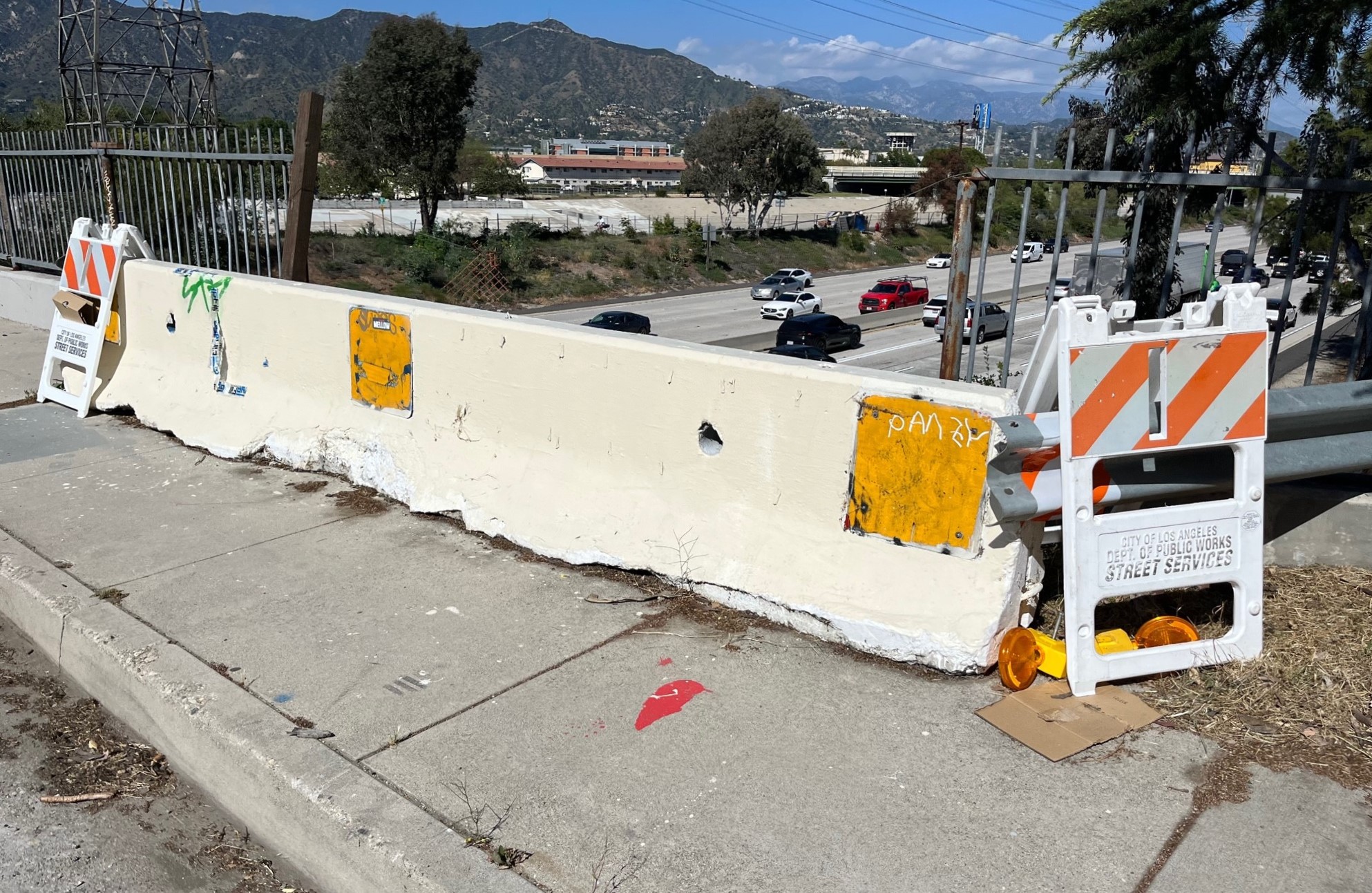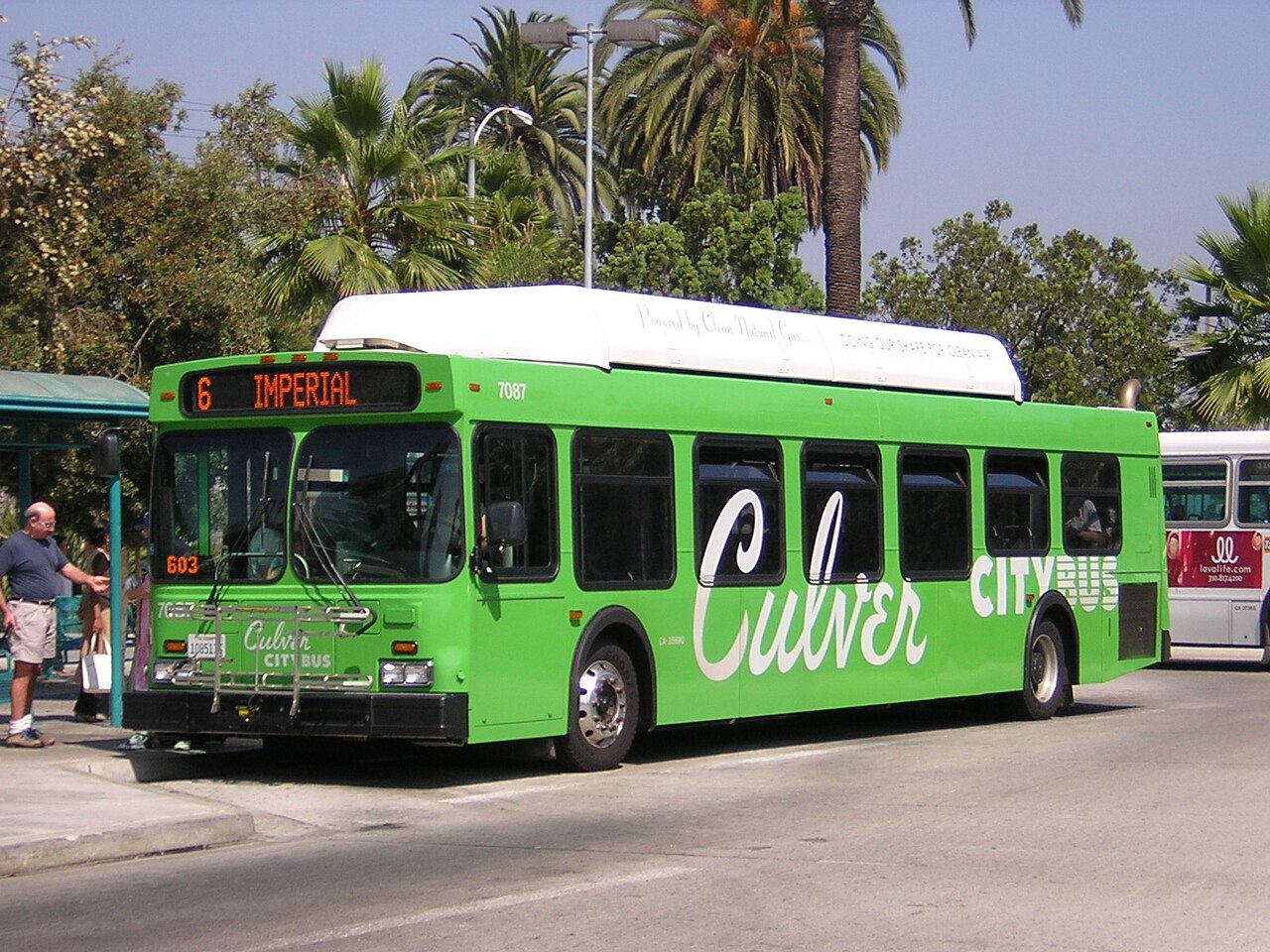Healthy Food Walk Around USC Neighborhood Unearths Tensions Between the University and the Community
10:10 AM PDT on September 14, 2012
If you were one of the participants in the South L.A. Healthy Food Ride/Walk this past weekend, you could be forgiven if you walked away a little confused about the purpose of the walk.
It started out simple enough.
The group – largely comprised of super-motivated teens from South L.A. vying for a spot on the Youth Action Coalition run by Building Healthy Communities South L.A. -- met at Mercado La Paloma, the new home of Community Services Unlimited’s (CSU) Village Market Place.
Tafarai Bayne, of TRUST South L.A. and RideSouthLA (a partnership between the Mobile Urban Mapping project at the USC Annenberg School for Communication and Journalism and TRUST South L.A.), laid out the plan for the day.
Participants were being tasked with helping the RideSouthLA team collect data and map the neighborhood. Specifically, they were asked to “take pictures of things that are healthy and unhealthy” (with regard to food choices) and “things that are safe or unsafe” (with regard to walking or biking conditions). The cellphone photos were to be sent in to the event site, to help compile a visual record of the walk.
Organizers then handed out maps of the streets we would be walking, so the participants could take notes elaborating on what they observed as they went.
Tafarai asked that, as they made their observations, they also think about why something was “safe” or “unsafe.” What might remedy an unsafe situation so that people would be more likely to ride or walk through their communities?
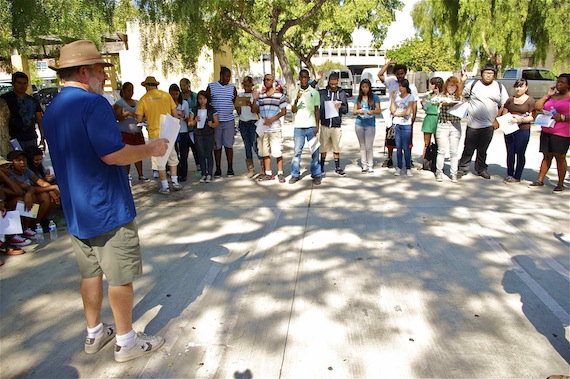
The mission was clear-cut and the students seemed ready. So, with that, we were off.
Able to do a longer route on bikes, Tafarai and Dyane Pascall of CSU led a handful of riders toward the Normandie School, where CSU has a mini farm. The rest of the group, led by Neelam Sharma, director of CSU, turned north on Grand Ave. and walked towards Jefferson. I joined that group, thinking it would be nice to take an easy stroll for a change.
Although it was beastly hot and there was nowhere to hide from the sun, the teens were undaunted and cheerful as they walked. They chatted me up about their aspirations and what they hoped to accomplish as part of the youth coalition. Student Jaren, for example, mentioned he enjoyed serving the community and was proud to be able to change the minds of people at his high school in Sherman Oaks about Compton, where he lives.
“They always ask me, ‘How do you not get shot and stuff?’ and all those other kinds of dumb, stereotypical things,” he said. “So, I tell them about the positive things that go on [there] And, now, every single person [I’ve talked to] has a different view of what it is like to live there.”
Just then, we arrived at the intersection of Jefferson and Flower Sts., where the students had to cross the Expo Line.
“Unsafe crossing!” a girl shouted as she snapped a photo of the gates that provided a physical barrier between pedestrians and the track.
Curious, I asked why she thought it was unsafe. It appeared far safer than most to me. Just a few blocks north, at 23rd and Flower Sts., there is no physical barrier between pedestrians and the tracks, despite it being a site where pre-teens regularly cross on their way to the middle school on Figueroa.
She thought about it for a moment, and then answered that the gates should lock when a train was coming through or when pedestrians should not be crossing. Or, maybe one of those big arms with flashing lights should come down across the intersection, mused another girl.
The walk sign came on, so they filed through the pedestrian gates, making their way across the street and snapping pictures as they went.
We stopped at Figueroa and Jefferson, grateful for the shade offered by the new residence hall on the corner. It was an opportunity to regroup, talk about what students had seen so far, and examine the food choices available at the shops built into the first floor of the building.
Now sweating and hot, the students loudly lamented the lack of greenery and shade to protect pedestrians from the elements.
“Did you guys notice anything about the buildings?” Neelam asked. “[There are] a lot of USC signs on the buildings. Did anybody notice that?”
They realized they had, once she mentioned it, but they quickly turned the conversation back to the broken sidewalks and the plethora of concrete.
She pressed on, “What do you notice about this area? It is known as USC Village.”
The students seemed impressed by the services – there was a pharmacy, a bank, a grocery store, restaurants, a coffee shop, and a nice place to sit outside. These were not available a few blocks east.
“It’s a little bit different,” she said, urging students to keep that in mind as they walked.
The push to highlight the divide between the surrounding community and USC became more overt as we moved on.
At the corner of Hoover and Jefferson, the site of the Tuesday Farmer’s Market, Jason, a CSU volunteer and former USC student in Social Work, noted that the market was set up specifically to “cater to USC students” and their needs. Once inside the campus, near the Tommy Trojan statue, he asked students to think about why it might be that USC’s campus environment was so green and inviting.
The students seemed to struggle to come up with answers that fit what he was looking for. Many simply enjoyed being in the campus area and missed what he was getting at altogether.
One suggested the campus was made beautiful so that people would be “wowed” by it and want to attend the university. Another suggested that because USC had a lot of resources, they did their best to provide a pretty environment for people. Another thought all the greenery made for a healthy environment for people to live, study, and relax.
Clearly having something else in mind but unsure of how to get the students to that conclusion, Jason haltingly summarized, “It is interesting, you know, that this place, you know, that is for students who come from all over, you know, that aren’t necessarily from this community…Where you are saying that it is so green and so pretty…that it is definitely something to think about.”
It wasn't until we reached their urban farm (located on the south side of Exposition Park) for a debriefing that it finally became clear what the walk was about for CSU.
As students fanned themselves with their maps under a canopy, Neelam again returned to the question of the abundance of USC banners along the streets and signs on the buildings.
“What does it tell us?” she wanted to know.
No answer.
She asked again, “What does that tell us?”
No answer.
“That the University of California [sic] is running or owning or something a lot of those buildings. Right? That’s what that tells us, right?”
She wanted to the kids to think about how different the campus-related areas were versus the rest of the neighborhood. The grocery stores and shops were located within the extended campus, not beyond it. And, they seemed much more geared to the needs and habits of students, not the community.
Jason reiterated his feeling that the services were there to cater to the needs of the USC students. Moreover, he continued, when you arrived at the boundaries of USC, there was “this feeling like it is sort of a different world [there]. When you cross into there…it almost feels like an alternate, pretty universe that was created for these students."
“Anybody know what the word is for when an entity -- a specific company or corporation or even an individual -- starts buying lots of land?” Neelam asked. “What’s that called? Anybody?”
Now, the kids seemed a little confused. This didn’t fit with the answers they had at the ready regarding what they had seen that was safe or unsafe. Nor did it fit with the conversations they had been having amongst themselves about how pretty they thought the campus was and how much they would have liked to see parks and trees like that in their neighborhoods.
“Entrepreneur?” asked one.
“Monopoly?” asked another.
“Monopolizing the land control...?” suggested Neelam. “There’s a specific term for it…?”
“Eminent domain?” asked another.
Neelam finally answered her own question.
“We’re…a lot of people are calling it land-grabbing," she corrected herself. "The people who have lived in that area or worked in that area…for years and for generations are being pushed out because the land values are going up. Anyone notice that happening? Anybody? Any stories anyone wants to tell about that? Anything anyone wants to share?”
There were some nods and some shifting in the seats among the students, but no one said anything.
So, Neelam offered her own story. She explained she was a resident and homeowner and that every few years she and her neighbors in the area were getting phone calls about selling their homes from buyers looking to build student housing.
“There’s a process been going on,” she said, gesturing toward the area south of King Blvd. “That is not to say that we’re hating on USC, but it is just to point out certain disparities that exist and what is happening with the land situation and the amenities that exist.”
The statement did not go uncontested.
Many of the people that had come to help shepherd the walk were not only part of the USC community, but also very active in finding innovative ways to use USC’s resources to benefit the surrounding neighbors. They did not all agree that just because the extended campus facilities might be more geared toward students, they were also therefore necessarily closed to others in the neighborhood.
Neelam countered that not everyone was welcome in those shops and that when neighbors tried to go there, other barriers would pop up. Namely, the police.
Dyane spoke about how he and Neelam’s son -- both young men of color in their twenties – would be routinely stopped by police once they got north of the African American Museum (located in Exposition Park). They had gotten so tired of being harassed that they had stopped going to certain places because it wasn’t worth the trouble or the emotional cost of constantly being questioned.
Otto Khera, on staff at USC and part of the RideSouthLA team, protested that he would also get stopped, depending on how he was dressed. He didn't know what it was that would trigger a police stop, he said, but he felt it wasn’t just about keeping neighbors out.
“Well, it’s called 'profiling,'” said Neelam, sharply.
Although silent, the students were now listening attentively, simultaneously interested and confused.
They were confused because we hadn't seen any evidence of this on the walk. The streets had been relatively empty -- devoid even of students -- and there was no visible police presence. Similarly absent from our route were the yellow-shirted monitors that stand on just about every corner in the areas surrounding USC where students live, ensuring student safety.
That doesn't mean CSU's concerns weren't merited.
I have heard stories from local youth about how their families are pressured to sell their homes and about how they are treated with suspicion when in close proximity to campus. I myself also remember being stopped by police when I lived around campus. Except, they were usually stopping me to tell me to stay away from certain areas. A nice girl like me didn't belong south of campus, they said, and it would probably only bring me trouble. Didn't I know that that was where the drug dealers hung out? People got shot there, they said. You don't want to be there.
Although the university has given back to the area in many ways, the divide between the USC community and the neighborhood it resides within is still very deep. And the more the university grows, the less room there seems to be for those original residents.
But those deeper undercurrents would have been impossible for students to have discerned on a quiet Sunday morning food walk.
Tafarai tried to help the students understand the issues at stake by offering a more historical perspective.
Talking about how he had grown up in the area, he said he had noticed that when the city-owned buildings around USC were bought up by the university and developers, things changed a lot. Shops and arcades that had drawn youth from the neighborhood were replaced with more upscale and student-friendly fare. The old 32nd St. Market (a grocery store) had been replaced and the free shuttles to the store, used by low-income and disabled residents from around South L.A., had been discontinued. That had been a particularly controversial step in the area's make-over and a blow to many residents, given the long-standing shortage of grocery stories in the area.
With the USC specific plan including a new grocery store and new shops at the University Village, neighbors are pessimistic about the extent to which their needs will be taken into account. The limited selection of a Trader Joe's or the higher prices of an upscale market like Whole Foods, for example, will only serve to further alienate residents.
Deftly bringing the discussion back to the students' mapping activity, Tafarai told them that by cataloging the kinds of services and foods available in the streets they had walked, they were providing researchers with a snapshot of the kind of neighborhood that was being created and of the kinds of needs being served.
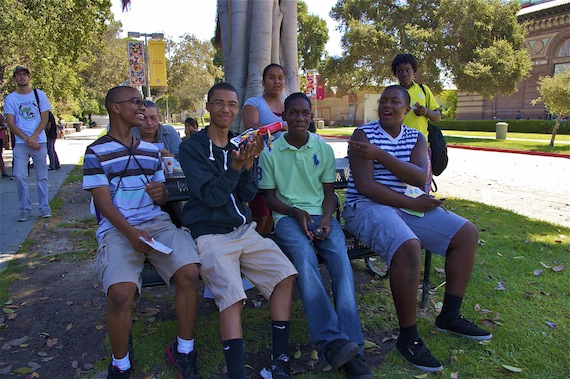
The activity had clearly shifted from a focus on the more innocent questions of what kind of foods or street conditions we had seen to deeper questions about who had access and why.
As we walked back to our start point, I pondered the prickly nature of the discussion.
It can be extremely hard to have civil discussions about gentrification, even among activists such as ourselves who have the same interest in social justice. The new arrivals -- however well-intended -- can never fully address the needs of the original residents. Their very presence means something in the neighborhood has changed, often to what the original residents feel is their detriment. By the time the remaining original residents are able to organize to have their voices represented at the table, that change is hard to undo.
Still, many seek to at least slow down that process of change, if not also see their needs incorporated into future plans.
Groups such as CSU, TRUST South L.A., SAJE, and Esperanza have been active in challenging USC to think more about creating an integrated community so that long-term residents can stay and feel welcome. Recently, they were effective in delaying a vote by the Planning & Land Use Management Committee on USC's $1 billion, 20-year expansion plan. They won't learn how effective, however, until the hearing next Tuesday, Sept. 18.
Over the next couple of weeks, I'll be looking at some of these deeper questions of how the expansion affects the neighborhood using the case of the Rolland Curtis building as an entry point.
The building's billionaire owner was hoping to turn the site, located on the corner of Vermont and Exposition, into housing for USC students. To do so, he neglected the upkeep of the buildings and sent unlawful eviction notices, scaring many of the low-income and immigrant tenants into leaving. Only after a year of legal wrangling with TRUST and Abode Communities, did he finally sell the building to the non-profits, making it possible for the remaining residents to stay on for now.
The purchase of the building by the non-profits is by no means a perfect solution, and the emotional toll the fight took on residents -- some of whom had resided there for decades -- was very high. Still, it does represent an innovative approach to keeping neighborhoods diverse and protecting residents' rights while illustrating how easily low-income residents can be pushed out when there is no organization to advocate on their behalf. Stay tuned.
Sahra is Communities Editor for Streetsblog L.A., covering the intersection of mobility with race, class, history, representation, policing, housing, health, culture, community, and access to the public space in Boyle Heights and South Central Los Angeles.
Stay in touch
Sign up for our free newsletter
More from Streetsblog Los Angeles
LAPD Was Crossing Against Red Light in Crash that Killed Pedestrian and Injured Six in Hollywood
The department says the officers had turned on their lights and sirens just before crossing, but won't say why they did so.
Freeway Drivers Keep Slamming into Bridge Railing in Griffith Park
Drivers keep smashing the Riverside Drive Bridge railing - plus a few other Griffith Park bike/walk updates
